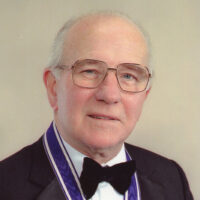
1995 Kyoto Prize Laureates
Materials Science and Engineering
/ Chemist
1926 - 2013
Professor Emeritus, The University of Hull
My Life Working with Liquid Crystals—and How They Work for Us
1995
11 /11 Sat
Place:Kyoto International Conference Center
New Development and Applications of Liquid Crystals
1995
11 /12 Sun
13:00 - 17:35
Place:Kyoto International Conference Hall
A chemist who has made fundamental contributions to research and development of liquid crystal materials, the key component of liquid crystal displays, which have become an indispensable part of today’s information-based society. He founded and organized the science of liquid crystal materials, and established practical molecular design methods for the application of these materials.
Dr. George William Gray has contributed fundamentally to the research and development of liquid crystal materials which comprise the Liquid Crystal Displays (LCD) that are so essential to today’s information based society. He created and systematized the liquid crystal materials science, and established a method of practical molecular design.
Liquid crystal materials are well known for their use as energy efficient display elements in countless products across a wide range of fields, including digital calculators, personal computers and LCD televisions. As such, they have become indispensable to today’s modern society.
Discovered as early as 1888, liquid crystals cannot be categorized as gaseous, liquid or solid phase, but indeed must be considered as a fourth material state, possessing both the fluidity of liquid and the anisotropic properties of solids.
Dr. Gray’s research on liquid crystal materials began in 1951 when he was teaching at the University of Hull. In the early days, he was involved in basic research on the molecular structure of liquid crystals, with special focus on systematizing the synthesis and properties of liquid crystal compounds to clarify their molecular structures and physical properties.
Although the use of liquid crystals as a display device by controlling them with an electric field had been proposed earlier, their practical use did not become possible until 1972, when Dr. Gray succeeded in developing cyanobiphenyl liquid crystals which, because of their low transitional temperature and chemical stability, were operational at room temperature. This achievement made today’s LCD functionally possible.
Today, even twenty years later, this series of compounds continue to be the most widely used standard liquid crystal compounds. Dr. Gray also clarified the fundamental molecular structure of nematic liquid crystal materials, which are at present the most widely used materials for general display purposes, and it can be said that this achievement still remains unsurpassed. Indeed, it is the wealth of knowledge that has resulted from Dr. Gray’s basic research in the field of liquid crystal materials that has fulfilled various needs for practical applications, and it can be said that the success of the liquid crystal science to this day has been brought about largely by his efforts.
Dr. Gray’s research in the area of synthesis and properties of liquid crystals has led him to succeed in creating liquid crystal compounds which are suitable for use in liquid crystal devices. His remarkable achievements in the area of molecular design research have been essential to the development of stable, durable liquid crystal compounds, and he has received acclaim from around the world for his contributions in creating functional, long-lasting liquid crystal materials. Without Dr. Gray’s distinguished service in this field, the liquid crystal device industry would never have developed to the levels it has attained today.
Dr. Gray has published countless papers concerning liquid crystal along with his many books and other works which have all become standard reference materials in the field. These have had an enormous influence on young researchers in this vital and growing field, and together with numerous other achievements, have distinguished Dr. George William Gray as indeed meriting the 1995 Kyoto Prize for Advanced Technology in the field of Materials Science and Engineering.
Profile is at the time of the award.